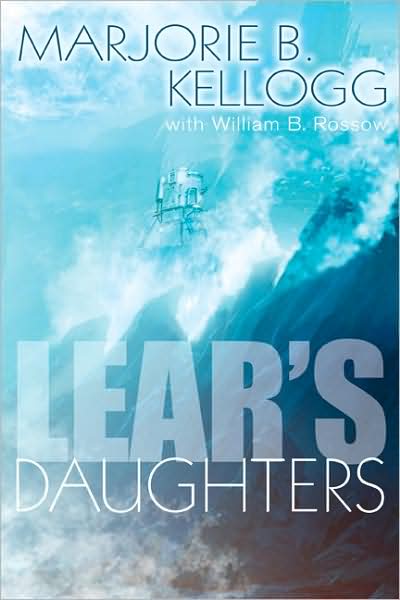Lear’s Daughters is by Marjorie Bradley Kellogg and William B. Rossow. I originally read it in two volumes as The Wave and the Flame and Reign of Fire. I believe Kellogg is the writer and Rossow the science consultant, because I have read other books by Kellogg alone but not by Rossow, but I don’t have definite information.
This is a good example of the kind of science fiction where people go to another planet to exploit it and learn about it, and the aliens who live there have ancient knowledge that turns out to be more advanced than you’d think, and in more interesting ways. This is not an original shape of story, and what makes Lear’s Daughters so great isn’t original ideas but the great twist Kellogg has put on this tale. This is a wonderful planet, and the alien Sawl culture is interesting and contains hidden depths. This is the a story of weather and anthropology and a science team from Earth who have very different priorities. The science fiction mystery has fascinating answers, but it’s the human conflict that drives the book and lifts it out of the ordinary.
No spoilers. It would be awful to spoil this book because the satisfying setting up and unwinding of everything is one of the things that makes it a joy, even when you know what happens. This is a book that deserves reading at its own pace so you can appreciate things as you get to them. The first time I read it, it had a yellow Gollancz hardback cover with nothing on it but the author and the title, so I knew nothing about it at all, and I think that was a good way to come to it. (And the title was “The Wave and the Flame”—it’s possible to argue that “Lear’s Daughters” gives too much away…) There are books that I want to read because hearing about them intrigues me, and books I want to read completely around a blind corner. This was one of those, and I wish it could be for you.
This is a revised edition. You know how sometimes you come back to a book and the suck fairy has been at it and the good book you remember isn’t there, only some thin little thing that you can’t like any more? The opposite has happened with this book. Kellogg and Rossow have rewritten the book for the republication, and made it better. In the original version, the prose started off flabby and a little purple, and the book took a while to get going. If I hadn’t been stuck in bed the first time I read it, I’m not sure I’d have got into it. It got abruptly better after a few chapters, as they got into the swing of it, and by the end it was amazing. This time, it’s been tightened up and it starts off well too. There is new stuff, which I’m ambivalent about, but the way the prose has been improved is just terrific news.
In the original version, there were occasional mentions of what a polluted hell Earth was. “This is like Venice used to be,” one of the characters says when contemplating an alien city with canals. For the new version, this has been made much more explicit, there are frequent mentions of how vile Earth is and how humanity has ruined it from greed. I’m not sure there needed to be quite as much, it was better when it was more subtle. Another change is that the problems are explicitly attributed now to global warming, whereas before global warming was one factor in amongst the other problems of industrial pollution. (I was reading something else recently that talked about an Earth polluted with industrial waste products, and noted that this seems to have receded as a trope in favour of climate change.)
The characters here are terrific, excellently drawn and with just the right degree of realism. The villain is successfully horrible—which is a harder trick than making the heroes sympathetic. Both humans and Sawls feel real—and the best character of all is the Sawl doctor, Ghirra, who hates his gods and would be a scientist if he lived on a better planet.
There’s a little bit of “natives are always magically right” here, and there’s a little bit of “what these people need is an Earthman,” so if you’re really violently sensitive to either of those tropes you might have a problem. I think the whole thing is subtle enough it’s commenting on the concepts rather than just repeating them, but you might not.
If you like anthropological SF, and alien planets with reasonable planetary science, and excellent characters, you will enjoy Lear’s Daughters.
Jo Walton is a science fiction and fantasy writer. She’s published eight novels, most recently Half a Crown and Lifelode, and two poetry collections. She reads a lot, and blogs about it here regularly. She comes from Wales but lives in Montreal where the food and books are more varied.










